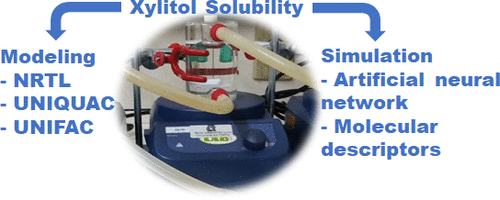当前位置:
X-MOL 学术
›
Ind. Eng. Chem. Res.
›
论文详情
Our official English website, www.x-mol.net, welcomes your
feedback! (Note: you will need to create a separate account there.)
Phase Equilibrium Involving Xylitol, Water, and Ethylene Glycol or 1,2-Propylene Glycol: Experimental Data, Activity Coefficient Modeling, and Prediction with Artificial Neural Network-Molecular Descriptors
Industrial & Engineering Chemistry Research ( IF 3.8 ) Pub Date : 2018-07-19 , DOI: 10.1021/acs.iecr.8b02480 Patrícia G. Machado 1 , Alessandro C. Galvão 1 , Weber S. Robazza 1 , Pedro F. Arce 2 , Bruna E. Hochscheidt 1
Industrial & Engineering Chemistry Research ( IF 3.8 ) Pub Date : 2018-07-19 , DOI: 10.1021/acs.iecr.8b02480 Patrícia G. Machado 1 , Alessandro C. Galvão 1 , Weber S. Robazza 1 , Pedro F. Arce 2 , Bruna E. Hochscheidt 1
Affiliation

|
The xylitol molecule is an important building block that can be used in the production of such interesting chemicals as ethylene glycol and 1,2-propylene glycol. The development of productive processes that enable this transformation depends on various experimental and theoretical information. In order to supply part of this demand, this work sought to study the solubility of xylitol in binary liquid solutions formed by water, ethylene glycol, and 1,2-propylene glycol in the temperature range between 293.15 and 323.15 K, covering the entire molar composition range of the solution. The Jouyban–Acree, NRTL, and UNIQUAC models were used in the correlation of experimental data, and the mUNIFAC model was applied in the prediction of experimental data. In addition, an artificial neural network associated with molecular descriptors was developed to simulate the data. Xylitol showed solubility in the pure components with decreasing values in the following order: water, ethylene glycol, and 1,2-propylene glycol. The solubility in binary solutions had intermediate values according to the intermediate concentration values. The models used proved capable of correlating or predicting the experimental data. The artificial neural networks had a satisfactory performance in the data simulation, and the best observed architecture used four layers of the type 7-3-3-1.
中文翻译:

木糖醇,水和乙二醇或1,2-丙二醇的相平衡:实验数据,活度系数建模和人工神经网络-分子描述符预测
木糖醇分子是重要的构建基块,可用于生产有趣的化学物质,例如乙二醇和1,2-丙二醇。能够实现这种转变的生产过程的发展取决于各种实验和理论信息。为了满足部分需求,这项工作试图研究木糖醇在水,乙二醇和1,2-丙二醇在293.15至323.15 K的温度范围内形成的二元液体溶液中的溶解度,覆盖整个摩尔溶液的组成范围。Jouyban–Acree,NRTL和UNIQUAC模型用于实验数据的关联,而mUNIFAC模型用于实验数据的预测。此外,开发了与分子描述符关联的人工神经网络来模拟数据。木糖醇显示出在纯组分中的溶解度,其值按以下顺序递减:水,乙二醇和1,2-丙二醇。根据中间浓度值,在二元溶液中的溶解度具有中间值。使用的模型证明能够关联或预测实验数据。人工神经网络在数据仿真中具有令人满意的性能,并且观察得最好的体系结构使用了7-3-3-1型的四层。根据中间浓度值,在二元溶液中的溶解度具有中间值。使用的模型证明能够关联或预测实验数据。人工神经网络在数据仿真中具有令人满意的性能,并且观察得最好的体系结构使用了7-3-3-1型的四层。根据中间浓度值,在二元溶液中的溶解度具有中间值。使用的模型证明能够关联或预测实验数据。人工神经网络在数据仿真中具有令人满意的性能,并且观察得最好的体系结构使用了7-3-3-1型的四层。
更新日期:2018-07-20
中文翻译:

木糖醇,水和乙二醇或1,2-丙二醇的相平衡:实验数据,活度系数建模和人工神经网络-分子描述符预测
木糖醇分子是重要的构建基块,可用于生产有趣的化学物质,例如乙二醇和1,2-丙二醇。能够实现这种转变的生产过程的发展取决于各种实验和理论信息。为了满足部分需求,这项工作试图研究木糖醇在水,乙二醇和1,2-丙二醇在293.15至323.15 K的温度范围内形成的二元液体溶液中的溶解度,覆盖整个摩尔溶液的组成范围。Jouyban–Acree,NRTL和UNIQUAC模型用于实验数据的关联,而mUNIFAC模型用于实验数据的预测。此外,开发了与分子描述符关联的人工神经网络来模拟数据。木糖醇显示出在纯组分中的溶解度,其值按以下顺序递减:水,乙二醇和1,2-丙二醇。根据中间浓度值,在二元溶液中的溶解度具有中间值。使用的模型证明能够关联或预测实验数据。人工神经网络在数据仿真中具有令人满意的性能,并且观察得最好的体系结构使用了7-3-3-1型的四层。根据中间浓度值,在二元溶液中的溶解度具有中间值。使用的模型证明能够关联或预测实验数据。人工神经网络在数据仿真中具有令人满意的性能,并且观察得最好的体系结构使用了7-3-3-1型的四层。根据中间浓度值,在二元溶液中的溶解度具有中间值。使用的模型证明能够关联或预测实验数据。人工神经网络在数据仿真中具有令人满意的性能,并且观察得最好的体系结构使用了7-3-3-1型的四层。











































 京公网安备 11010802027423号
京公网安备 11010802027423号